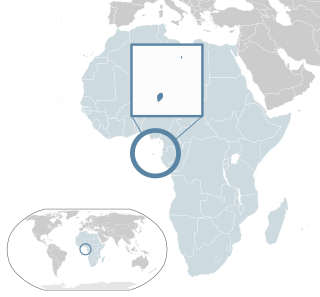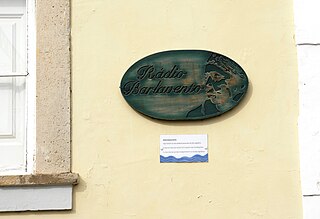Related Research Articles

São Vicente is one of the Barlavento Islands, the northern group within the Cape Verde archipelago in the Atlantic Ocean, off the West African coast. It is located between the islands of Santo Antão and Santa Luzia, with the Canal de São Vicente separating it from Santo Antão.

Forro Creole or Sãotomense is a Portuguese creole language spoken in São Tomé and Príncipe. It is also called by its native speakers as sãotomense creole or santomense creole.
The morna is a music and dance genre from Cape Verde.
Sergio Frusoni was a poet and promoter of the Cape Verdean Creole language.

Boa Vista, also written as Boavista, is a desert-like island that belongs to the Cape Verde Islands. At 631.1 km2 (243.7 sq mi), it is the third largest island of the Cape Verde archipelago.
Cape Verdean Creole is a Portuguese-based creole language spoken on the islands of Cape Verde. It is also called Kriolu or Kriol by its native speakers. It is the native creole language of virtually all Cape Verdeans and is used as a second language by the Cape Verdean diaspora.
Santiago Creole is the name given to the Cape Verdean Creole spoken mainly on Santiago Island of Cape Verde. It belongs to the Sotavento Creoles branch of Creole.

Baltasar Lopes da Silva was a writer, poet and linguist from Cape Verde, who wrote in both Portuguese and Cape Verdean Creole. With Manuel Lopes and Jorge Barbosa, he was the founder of Claridade. In 1947 he published Chiquinho, considered the greatest Cape Verdean novel and O dialecto crioulo de Cabo Verde which describes different dialects of creoles of Cape Verde. He sometimes wrote under the pseudonym Osvaldo Alcântara.

Cape Verdean Portuguese is the variety of Portuguese spoken in Cape Verde.
The coladeira is a music genre from the Cape Verde islands in the central Atlantic Ocean.
São Vicente Creole is the name given to the variant of Cape Verdean Creole spoken mainly in the São Vicente Island of Cape Verde. It belongs to the Barlavento Creoles branch. This form of the Cape Verdean Creole has about 80,000 to 100,000 speakers primarily in the São Vicente island, but also in a large segment of the Cape Verdean diaspora population. It is the second most widely spoken Cape Verdean creole. It has produced literature from a lot of writers and musicians including Sergio Frusoni and many more.
Brava Creole is the name given to the variant of Cape Verdean Creole spoken mainly in the Brava Island of Cape Verde. It belongs to the Sotavento Creoles branch. The speakers of this form of Capeverdean Creole are 8,000. One of the least spoken being seventh place and one of the firsts to have written literature, in which Eugénio Tavares wrote some of his poems.
Santo Antão Creole, is the name given to the variant of Cape Verdean Creole spoken mainly in the Santo Antão Island of Cape Verde. It belongs to the Barlavento Creoles branch. It is ranked third of nine in the number of speakers and it is before Fogo and after the neighbouring São Vicente.
Maio Creole is the name given to the variant of Cape Verdean Creole spoken mainly in the Maio Island of Cape Verde. It belongs to the Sotavento Creoles branch. It numbers the entire island population which includes a small part which also speaks Portuguese, in 2005, the percentage was 1.36%.
Sal Creole is the name given to the variant of Cape Verdean Creole spoken mainly in the island of Sal of Cape Verde. It belongs to the Barlavento Creoles branch. The speakers of this form of Cape Verdean Creole are 15,000.
São Nicolau Creole is the variant of Cape Verdean Creole spoken mainly in the São Nicolau Island of Cape Verde. It belongs to the Barlavento Creoles branch. The speakers of this form of Cape Verdean Creole are 15,000 and it is the fifth most spoken form of Creole in the language. Literature is rarely recorded but the form of the Capeverdean Creole has been recorded in music.

Rádio Barlavento was a radio station in Cape Verde which broadcast in the Portuguese language from 1955 until 1974. It was a shortwave (CR4AC) station broadcasting on 3930 kHz. From 1947 until 1955 it was called Rádio Clube do Mindelo. In 1974 it was seized by members of the Partido Africano da Independência de Guiné-Bissau e Cabo Verde - PAIGC, who sought to "get the station out of hands of those who aligned with colonial power." After this the station became Radio Voz de Sao Vicente. The station served the entire Barlavento island group including Santo Antão, São Vicente, São Nicolau, Sal and Boa Vista. The station was located in a building near downtown Mindelo, which is now the Centro Nacional de Artesanato e Design, and broadcast Cape Verdean traditional music, local programs, and Portuguese and some international programming. Rádio Voz de São Vicente later became an affiliate of RCV, Mindelo's own station would have another separate one and would be named Ràdio Nova.
O dialecto crioulo de Cabo Verde is a Capeverdean book published in 1957 by Baltasar Lopes da Silva. As the title was the spelling used after the 1945 Portuguese Orthography Agreement, its modern spelling is titled O Dialeto Crioulo de Cabo Verde.
Manuel Veiga is a Cape Verdean writer, a linguist with references in the national and international level and a politician. He was minister of culture of his country from 2004 to 2011.

Colá is a musical genre of Cape Verdean music
References
- ↑ Estimate of a part of the residential population in 2005: Instituto Nacional de Estatística: "Repartição percentual da população residente segundo concelho e meio de residencia". Archived from the original on 2008-01-26. Retrieved 2016-03-18.